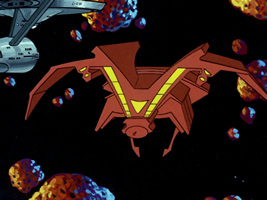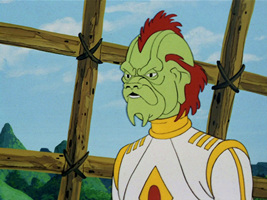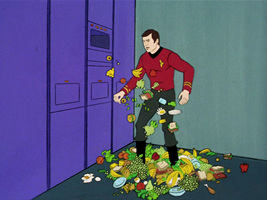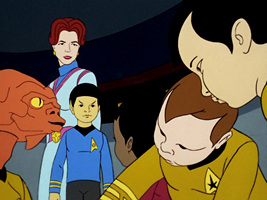The Animated Series (TAS) Season 2 Guest Reviews
Season 1Season 2
The Pirates of Orion
Synopsis
Stardate 6334.1: When Mr. Spock contracts a deadly case of choriocytosis, the Enterprise races to rendezvous with the USS Huron, a Starfleet freighter carrying the drug strobolin that is essential for Spock's treatment. En route, the Huron is attacked by an Orion pirate vessel, which steals its cargo including the strobolin. The Enterprise is able to follow the Orions' trail, capture the vessel, and recover the cargo, curing Mr. Spock. As a result of the incident, Captain Kirk intends to end the Federation's recognition of Orion as a "neutral" power.
Commentary
Like Vulcans, Orions were introduced in Star Trek's original pilot "The Cage." Vulcans received the most development of Star Trek's aliens through TOS and its movies. (Added to this is a substantial amount of problematic attention given to Vulcans in "Star Trek: Enterprise.") Similarly Klingons received an even greater degree of development, beginning with their language "Star Trek III: The Search for Spock," and their culture in "Star Trek: The Next Generation." And we learned more than anyone probably wanted to know about Bajoran religion and politics in "Star Trek: Deep Space Nine." Along the way, we've gained a reasonably solid sense of the Romulans, the Cardassians, and the Ferengi.
Not so, the Orions. Orions have continued to receive a significant number of mentions and appearances throughout the franchise (TOS, TAS, DS9, VOY, ENT, DIS, LOW), but the portrayals are generally shallow, inconsistent, and even incoherent. Incredibly, after mentions in 6 previous series, the first time we've seen the Orion homeworld depicted is in a brief holodeck simulation in LOW: "Second Contact." And although Ensign D'Vana Tendi (introduced in the same episode) is the first Orion to be a main character in any series, almost nothing has set her apart as distinctly "Orion".*
Although an Orion conspiracy was central to the plot of TOS: "Journey to Babel," TAS: "The Pirates of Orion" was the first Star Trek episode to focus on the Orions. Once again we see that the Orions are a minor power, which is avowedly "neutral," albeit one that is continuously exploiting that status in order to sanction smuggling and piracy. We also reprise the idea, established in "Journey to Babel," that Orions will commit suicide rather than allow themselves to be caught in the act. Unfortunately, aside from these details, "The Pirates of Orion" adds little in the way of useful development.
In "Journey to Babel," the Orion ship was portrayed as a tiny blob of light due to budget constraints (and we don't see much more than this in TOS-R). "The Pirates of Orion" introduces the first design for an Orion ship. While it looks cool enough in its head-on view, we never have a side or rear shot to understand how it works. Unlike the Orion ship in "Journey to Babel" which was smaller but faster than the Enterprise, the Orions in "The Pirates of Orion" indicate that their ship can't match the Enterprise in speed or weaponry. However, bizarrely, when the Enterprise and the Orion ship square off, the latter appears substantially larger than a Constitution-class starship --- hardly an appropriate scale for a pirate marauder. Likewise, the Orions wear uniforms that seem more appropriate for cartoon supervillains than for pirates. Worst of all, throughout the episode, "Orion" (oh-RYE-un) is consistently mispronounced (ARR-ee-un)!
Rather than taking the opportunity to develop anything interesting about the Orions and their culture, the episode reduces them to aliens of the week. Instead the focus once again is on the race to treat a rare disease with an even rarer drug (already a very tired trope in TOS).
*At least nothing distinctly Orion as of the first seven episodes of the first season of "Star Trek: Lower Decks," when this review was written.
Annotations
- Remarkable Starfleet freighter: The episode introduces the USS Huron (NCC-F1913) with a remarkable TOS-era design, much larger than the Antares-type ships introduced in TAS: "More Tribbles, More Troubles." Like the crews of the Antares (TOS: "Charlie X"), Constellation (TOS: "The Doomsday Machine"), and Exeter (TOS: "The Omega Glory"), the crew of the Huron have their own distinct insignia badge.
Rating: 2 (John Hamer)
Bem
Synopsis
Stardate 7403.6: The Enterprise is hosting Ari bn Bem, a Pandronian observer with the honorary rank of commander. Although Commander Bem has remained in his quarters through most of the tour, he insists on joining the landing party when the ship reaches Delta Theta III. Kirk is reluctant to allow Bem beam down to the planet because the primitive natives are potentially hostile. On the planet's surface, Commander Bem surreptitiously replaces Kirk's and Spock's phasers and communicators with non-functioning replicas. As the landing party prepares to set up equipment to monitor the natives, Bem runs into the rain forest. Kirk and Spock follow and discover that a party of Delta Thetan hunters have captured the Pandronian. Although Kirk and Spock realize their communicators and phasers are non-functional, they decide to follow Bem to effect a rescue; instead they are themselves captured by the natives. Imprisoned together in wooden cages, Bem reveals that Pandronians are "colony" lifeforms able to disassemble themselves (and thus Bem is able to escape through the bars). He also admits that he took the phasers and communicators in order to test Kirk and Spock's capacities. Once again armed, Kirk and Spock escape their cages, but immediately attract the attention of a powerful energy being that serves as the guardian of the Delta Thetans. Eventually, Kirk is able to negotiate with the energy being, which allows the landing party to depart the planet, which is placed under strict quarantine.
Commentary
What a mess of an episode! David Gerrold, author of TOS: "The Trouble with Tribbles," and TAS: "More Tribbles, More Troubles," returns for his last and least successful outing Star Trek outing. Originally pitched as a season 3 TOS episode, "Bem" was apparently subject to massive re-writes that fundamentally altered its initial premise and unsuccessfully wedged in an unconnected Gene Roddenberry plotline.
The original concept was for the Enterprise to host an officer who is completely alien in both physiology and philosophy, an actual BEM or "Bug-Eyed Monster." However, as drawn in the episode, Bem appears humanoid. Despite having sufficient relations with planet Pandro to accept an observer on a starship, no one in the Federation is apparently aware that Pandronians are "colony" lifeforms whose head, torso, arms, and legs can separate and walk or float around. The Pandronian intellect is apparently also a combination of brains in the individual parts, since Bem decides at one point that the particular merger has failed and should be dissolved permanently. The fact that the separated legs need to have their own little arms and grabbers is weird. If the separated head, torso, and presumably arms can just float around, why do the legs need to walk? As presented, Pandronian physiology is absurd.
The Pandronians' "alien" culture is also muddled. Gerrold originally intended for Bem to be a kind of practical joker and vestiges of this remain when Bem sets the transporter coordinates so that Kirk and Spock materialize above water and immediately fall into a lake, and again when Bem swaps out their equipment for fakes. Given Gerrold's previous success with comedy, this might have been a fruitful direction to take the script. Instead, these become inexplicable, isolated incidents and the Pandronian philosophy in general comes off as inscrutable.
Unfortunately, the moral is likewise muddled. Generally, when developing a story where our heroes learn about someone truly alien, they ought to first be turned off by the ways differences lead to problems. And then later, they come to appreciate that the alien culture that originally seemed to wrong, actually has a understandable rationale. Instead, it's Bem who comes to realize that he was misbehaving according to human expectations and the episode's moral is that he needs to learn from his mistakes. As Star Trek morals go, this one is flawed at best. Interestingly, when the premise of an alien officer exchange program is recycled in TNG: "A Matter of Honor," once again it's the alien officer who has to learn why his customs were mistaken.
The Roddenberrian B-plot involves a "god-like" energy being who is supervising the evolution of a primitive species operating at a hunter-gatherer level of technology. In some ways, this is similar to TOS: "The Apple," where a planet of primitives are being overseen by the computer Vaal. Although Kirk quickly decides to destroy Vaal, whom the natives revere as a god, he has the opposite reaction here and it's not immediately clear why. Why is it better for a primitive society to be controlled by energy being acting as a god than a computer acting as a god? The episode's conclusion comes of as especially paternalistic. At least the people of Vaal got a chance to speak (prior to being ignored). Kirk doesn't even bother to try to communicate with the Delta Thetans.
Annotations
- Remarkably dubious name: The Pandronian observer is named "Ari bn Bem." The name deliberately references the Scifi slang phrase "Bug-Eyed Monster," of which BEM is an acronym. Although juvenile in-jokes and references have frequently made their way into Okudagrams (usually meant to be illegible), this is an example where an in-joke has inappropriately risen to the level of the title character's name. Episode author David Gerrold is Jewish and the rest of Bem's name is apparently also some sort of insider reference as "Ari" is a common Hebrew name meaning "lion of God" and "bn" means "son of" in Hebrew.
- Remarkable indigenous species: The Delta Thetans are reptiloids that look really cool. I really would have preferred that the episode focus on them. Instead, they're relegated to a non-speaker role behind Bem and their guardian energy being.
- Recycled premise: A planet of primitives protected by a godlike energy being guardian was recycled in TNG: "Justice" and later VOY: "Caretaker." The premise of an alien officer exchange is revisited in TNG: "A Matter of Honor." The idea that Starfleet sets up equipment to monitor primitive species is revisited in TNG: "Who Watches the Watchers?" and "Star Trek: Insurrection."
- Remarkable name: This is the first episode to establish "Tiberius" as Kirk's middle name. Kirk's full name repeated half a dozen times during the episode.
- Remarkably obtuse greeting: "Kirk to alien intelligence. This is captain James Tiberius Kirk calling the ruling intelligence of this planet. Answer me, please... This is captain James Tiberius Kirk calling the ruling intelligence of this planet. Do you hear me? Kirk to entity. Kirk to entity?"
Rating: 3 (John Hamer)
The Practical Joker
Synopsis
Stardate 3183.3: Synopsis in main TAS listing
Commentary
Like many TAS episodes, "The Practical Joker" is rushed with some plot holes. Most of the jokes are not even very funny. Worst of all, the ship creates itself an inflatable Enterprise of equal size. What the heck? Why would the Enterprise be equipped with an inflatable fake in the first place? Did the computer create it? If so, how? It all seems too silly to me.
Annotations
- Remarkable prank: Kirk has a new shirt made for himself and the computer prints on the back of it "Kirk is a Jerk". Probably the only funny joke of the episode.
- Remarkable technology: The rec room. Could it be that Starfleet already had holodecks on some of their ships? This would not work well with TNG where is is assumed that holodecks are a fairly new technology. However, since this series is animated (and poorly at that) we could assume that the rec room is not as realistic as a holodeck from the 24th century. If this were the case, then Riker's comment about being astonished by the perfection of the holodeck would make sense. Also, in "The Practical Joker" the team decides to try and find a wall since the room is only so big. This trick would not work in the many holodeck malfunctions of the TNG era.
- Remarkable voice: Majel Barrett seems to provide the voice for the ships computer. Majel would later do the voice for Starfleet ship computers in the TNG era.
Rating: 3 (Chris)
The Practical Joker
Synopsis
Stardate 3183.3: To escape a Romulan ambush, Kirk directs the Enterprise through an energy field, which causes serious damage to the ship's main computer. The computer begins to behave illogically, seemingly delighting in playing "practical jokes" on the crew. Attempts to disengage the computer fail, leading to a loss of manual control over the ship. After the computer returns the Enterprise to the Neutral Zone to play a prank on the Romulans, Kirk is able to trick it to traveling back through the energy field which reverses the damage.
Commentary
In John M. Ford's excellent comedic Star Trek novel, How Much for Just the Planet?, the Enterprise is testing a decoy that has the appearance and sensor profile of a Constitution-class starship, but is actually an inflatable balloon. The idea for the decoy comes from TAS: "The Practical Joker." If the episode had taken the time to establish the existence of the balloon decoy somewhere the start of the story (as was done in the novel), deploying it at the end might have been perfect. The idea that the Romulans fear dishonor and that the Enterprise computer wants to revenge itself on the Romulans by tricking them with a practical joke is very solid. Unfortunately, the fact that the balloon isn't foreshadowed or explained (why would it be 10x larger than the Enterprise?!) undercuts both the point and the potential humor. How Much for Just the Planet? is a pretty funny novel. "The Practical Joker"? Sadly not so funny.
The jokes presented are: glasses that cause the crew to spill on their uniforms; a bendy fork that drops food; an binocular instrument that paints circles around Spock's eyes; food spraying out of the synthesizer slot, including a pie-in-the-face for Scotty; the phrase "KIRK IS A JERK" written on the backs of all Kirk's uniforms; coating the deck floor with slippery ice; creating a holographic pit/trap and later a blizzard the "Rec Room" (proto-holodeck); flooding the environmental systems with "laughing gas;" and finally diverting the ship to Romulan Neutral Zone and deploying a giant, inflatable balloon duplicate of the Enterprise. Circle-eye and pie-in-the-face are classics and were mildly funny and I kind of like "Kirk is a Jerk," but overall the humor was too juvenile to get me to laugh. If the practical jokes had been funny, this might have been a really great little romp.
Much more significant is the episode's introduction of a holodeck. Although called the "Rec Room," the characteristics are largely identical to the Holodeck as it's later established in TNG: "Encounter at Farpoint." Also identical: it immediately malfunctions and nearly turns deadly for everyone trapped inside. The scene where Scotty and the engineers are outside the doors, trying to pry them open is repeated exactly in TNG: "The Big Goodbye" and many later installments.
Annotations
- Remarkable reprises: The Enterprise computer creates a holographic blizzard in the Rec Room to prevent McCoy, Uhura, and Sulu from reaching the exit. On the holodeck in LOW: "Terminal Provocations," Ensign Rutherford runs a blizzard program to wear down Badgey. Sulu previously nearly froze to death in TOS: "The Enemy Within."
- Nitpicking: Although Kirk's solution of tricking the computer is better than talking it into committing suicide, once again the writers of TOS and TAS have no understanding of computers. It's also not clear why a second trip through the energy field would correct the problem; more likely it would make matters worse.
- Actually funny ending quote: "Turn off those food synthesizers! We're knee-deep in desserts and they're still pouring out!" -Romulan Commander. After their own computers become practical jokers, the Romulans finally receive their "just desserts."
Rating: 4 (John Hamer)
The Counter-Clock Incident
Synopsis
Stardate 6770.3: While transporting Commodore Robert April and his wife, Dr. Sarah April to Babel, the Enterprise encounters an alien scout ship that is hurtling itself into the Beta Niobe supernova at the impossible velocity of warp 36. Attempting to stop the pilot from committing suicide, the Enterprise locks a tractor beam on the ship. But instead of halting its descent, the Enterprise is pulled along and collides with the supernova, which turns out to be a gateway into a negative "Counter-Clock Universe." The Enterprise travels to the planet Arret, which corresponds to Earth in the positive universe, in an attempt to return to normal space. In the meantime, it's learned that the crew are growing younger at a rapid pace. Eventually Kirk, Uhura, Sulu, and the others are reduced to toddlers and Spock becomes a teenager. Fortunately, Commodore April started out old enough to remain an adult long enough to pilot the Enterprise back home.
Commentary
In the Seinfeld episode, "The Bizarro Jerry," Jerry tries to explain the relationship of Superman and Bizarro to Elaine.
Jerry: "...Bizarro Superman. Superman's exact opposite, who lives in the backwards bizarro world. Up is down. Down is up. He says 'Hello' when he leaves, 'Good bye' when he arrives."
Elaine: "Shouldn't he say 'Bad bye'? Isn't that the, opposite of 'Good bye'?"
Jerry: "No. It's still a goodbye."
Elaine: "Uh, does he live underwater?"
Jerry: "No."
Elaine: "Is he black...?"
Jerry: "Look. Just forget it, already, all right?"
As Elaine quickly points out, the idea of Bizarro as a backwards Superman doesn't hold up to even casual scrutiny. Unfortunately, that's also true of the "Counter-Clock Universe." In the Counter-Clock Universe, space is white light and the stars are black spots. But why isn't everything else inverted color-wise? In the Counter-Clock Universe, the Enterprise and all other ships fly backwards, but why aren't they also upside-down? The planet that corresponds galactographically with Earth is "Arret" --- which is "Terra" spelled backwards. But why isn't the Beta Niobe supernova not known as the "Eboin Ateb" in the Counter-Clock Universe?
As with the Bizarro Superman, the premise of the Counter-Clock Universe works better if you don't ask too many questions. The episode's setup is a vehicle to show the Enterprise crew as teenagers and then toddlers, which reverses the setup in TOS: "The Deadly Years," when Kirk and other officers are rapidly aging. This has the potential for a lot of fun, but the cast do very little as their younger selves other than be confused. Much more zaniness is had by the youthened Picard, Guinan, Ro, and Keiko in TNG: "Rascals."
The Enterprise crew are getting younger because time is experienced in reverse in the Counter-Clock Universe. As Spock comments when he observes that Karla Five's son is an old man (Karl Four) and her father (presumably named Karl Six) is a baby, "Most logical, if the flow of time is reversed, then one is born at an old age and dies in infancy. Your descendants are born before you, and your ancestors are born after you." Except how does it work to be "born" as an old man?
None of this explains why the Enterprise crew are getting younger at an amazingly accelerated rate. In the end, the fact that there are more conceptual holes than substance to the "Counter-Clock Universe" undercuts what might otherwise be a good episode.
Annotations
- Remarkable officers: Commodore Robert April is established in this episode as the Enterprise's original captain, predating James Kirk and Christopher Pike. Dr. Sarah April was the original Chief Medical Officer.
- Remarkable flower: Dr April's Capellan flower has a lifespan of only a few hours. It blooms and then wilts in our universe and then reverses its lifespan in the Counter-Clock Universe. The germination rate of another plant sample (Diomedian scarlet moss) was one of the "clues" that alerted Dr. Crusher to a lost day in TNG: "Clues".
Rating: 4 (John Hamer)







 "The Pirates of Orion"
"The Pirates of Orion"











